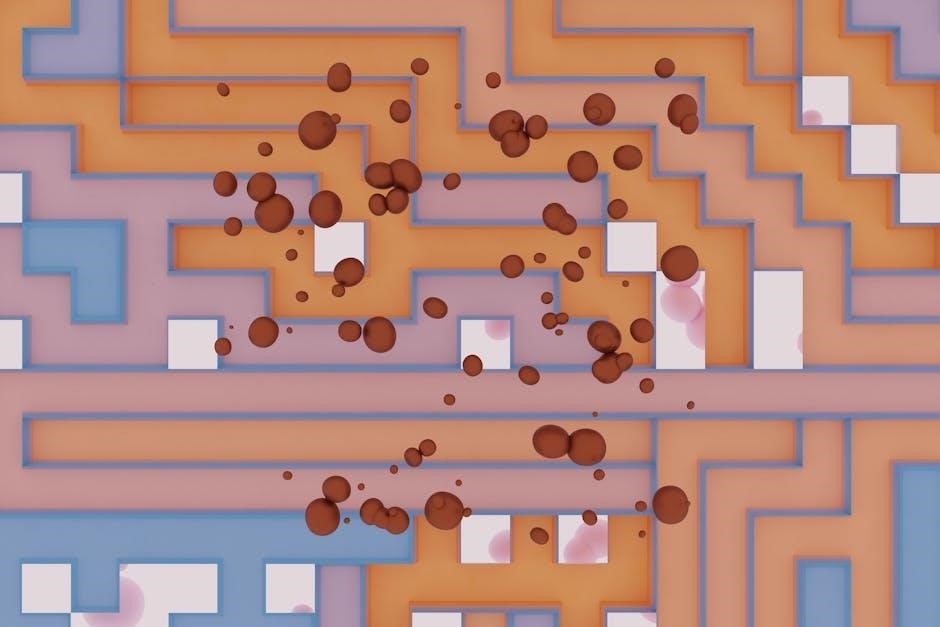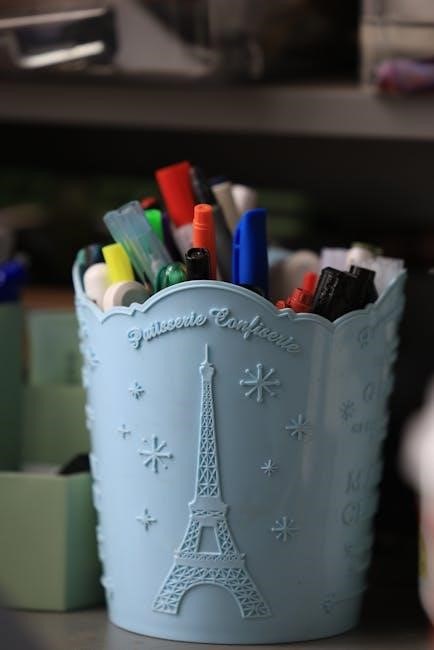A graphic organizer is a visual tool designed to help writers structure and organize ideas for essays, such as the 5-paragraph essay format.
1.1 What is a Graphic Organizer?
A graphic organizer is a visual tool designed to help writers structure and organize their ideas for essays, such as the 5-paragraph essay format. It provides a clear framework for brainstorming, outlining, and arranging content into sections like introduction, body paragraphs, and conclusion. This tool is particularly useful for students and writers who need to visually map out their thoughts to ensure coherence and logical flow in their writing. It simplifies the essay-writing process by breaking it down into manageable parts.
1.2 Importance of Using a Graphic Organizer for Essay Writing
Using a graphic organizer is essential for structuring essays effectively. It helps writers brainstorm, organize, and visualize their ideas, ensuring clarity and coherence. This tool is particularly beneficial for visual learners, as it provides a clear framework for the introduction, body paragraphs, and conclusion. By breaking down the essay into sections, it simplifies the writing process, saves time, and ensures that all key points are included. It also enhances creativity and helps maintain logical flow throughout the essay.
1.3 Structure of a 5-Paragraph Essay
A 5-paragraph essay consists of an introduction, three body paragraphs, and a conclusion. The introduction presents the thesis statement, while each body paragraph focuses on a single main idea supported by evidence. The conclusion summarizes key points and restates the thesis. This structure ensures logical flow, making it easier for writers to organize their thoughts and for readers to follow the argument. It is a widely used format in academic writing due to its clarity and effectiveness.

Breaking Down the Graphic Organizer Sections
The graphic organizer is divided into sections for introduction, body paragraphs, and conclusion, each providing space to outline key points and supporting details effectively.
The introduction section of the graphic organizer is designed to help writers craft a compelling opening for their essay. It typically includes space for a hook, background information, and a thesis statement. This section ensures the writer presents a clear main idea and sets the tone for the entire essay. By outlining these elements, students can create a structured and engaging introduction that effectively introduces the essay’s topic and grabs the reader’s attention; Proper organization here lays the foundation for a coherent and focused essay.
2.2 Body Paragraphs Section
The body paragraphs section of the graphic organizer is divided into three main sections, each corresponding to a paragraph in the essay. Each section typically includes space for a topic sentence, evidence or examples, analysis, and a concluding sentence. This structure helps writers develop clear and focused arguments, ensuring each paragraph supports the thesis statement. By organizing ideas visually, students can maintain logical flow and effectively address each point, making the essay more coherent and persuasive. This section is essential for detailing the essay’s main arguments.
2.3 Conclusion Section
The conclusion section of the graphic organizer helps writers craft a strong ending to their essay. It typically includes space for restating the thesis statement, summarizing the main points from the body paragraphs, and providing a closing thought or final impression. This section ensures the essay ends cohesively, reinforcing the central argument without introducing new information. The organizer guides students to reflect on their key ideas and leave the reader with a memorable takeaway, making the conclusion both impactful and effective in wrapping up the essay. Proper structure is emphasized here for clarity and completeness.

How to Use the Graphic Organizer Effectively
Use the graphic organizer to brainstorm ideas, outline structure, and organize content. Start with the introduction, then detail each body paragraph, and conclude with a summary. This tool helps ensure clarity and coherence, guiding writers through each step of the essay-writing process effectively.
3.1 Brainstorming Ideas for Each Section
Begin by brainstorming ideas for each section of the essay. Start with the introduction, considering hooks, thesis statements, and background information. For body paragraphs, focus on main points and supporting details. Use mind mapping or listing to generate ideas, ensuring each section aligns with the essay’s structure. This step helps create a clear roadmap, making the writing process more efficient and organized. Effective brainstorming ensures all key points are covered before drafting the essay.
3.2 Organizing Thoughts and Ideas
Once ideas are brainstormed, organize them using the graphic organizer. Categorize ideas into introduction, body paragraphs, and conclusion. Prioritize main points and supporting details, ensuring a logical flow. Use the organizer to visually arrange topics, making it easier to structure the essay. This step helps identify gaps and ensures each section is balanced. Proper organization enhances coherence and makes the writing process smoother, allowing for a clear and focused essay.

3.3 Transferring Ideas to the Essay
After organizing thoughts, transfer ideas from the graphic organizer to the essay. Begin with the introduction, ensuring the thesis statement is clear. Develop each body paragraph by expanding main points and supporting details. Use transitions to maintain flow between sections. Conclude by summarizing key ideas and restating the thesis. Ensure each section aligns with the structure outlined in the organizer. This step transforms visual planning into a coherent, well-structured essay, making the writing process efficient and organized.

Benefits of Using a 5-Paragraph Essay Graphic Organizer
Using a 5-paragraph essay graphic organizer improves writing clarity, enhances structure, and saves time by visually organizing ideas, making the essay-writing process more efficient and focused.
4.1 Improves Writing Clarity
A 5-paragraph essay graphic organizer enhances writing clarity by providing a structured format to break down ideas into clear sections. With dedicated spaces for the introduction, body paragraphs, and conclusion, writers can ensure each part of their essay is concise and focused. This visual organization helps avoid confusion and ensures that the essay flows logically. By guiding the writer to present their thoughts in a coherent manner, the graphic organizer makes the final essay easier for readers to understand and follow. Additionally, it helps students stay on topic, preventing unnecessary tangents and keeping the content relevant. The clear structure also allows for better use of transitions between paragraphs, further improving the overall readability of the essay;
4.2 Enhances Organization and Structure
A 5-paragraph essay graphic organizer is a powerful tool for enhancing organization and structure in writing. By dividing the essay into clear sections—introduction, body paragraphs, and conclusion—it helps writers maintain a logical flow. The organizer ensures that each section has a defined purpose, preventing overcrowding of ideas. This structured approach guides students to allocate their content evenly, ensuring each paragraph serves its intended function. The visual layout also makes it easier to categorize thoughts, leading to a more balanced and cohesive essay. This organization fosters a systematic writing process, reducing the risk of missing key elements and promoting a polished final product.
4.3 Saves Time in the Writing Process
Using a 5-paragraph essay graphic organizer significantly saves time during the writing process. It streamlines brainstorming by providing a clear framework for ideas, ensuring writers focus on relevant content. The structured format reduces the need for extensive revisions by organizing thoughts upfront. This tool also minimizes time spent on reorganizing paragraphs, allowing writers to allocate more time to refining their arguments and language. By simplifying the planning stage, the graphic organizer helps complete essays more efficiently and effectively.
Tips for Filling Out the Graphic Organizer
Start early, use bullet points, and review each section to ensure clarity. Focus on one idea per box to maintain organization and coherence throughout the process.
Begin by brainstorming a strong hook to grab attention, such as a quote or question. Next, provide background information to set context. Finally, craft a clear thesis statement that outlines the essay’s main arguments. Use bullet points to list key ideas, ensuring they align with the essay’s focus. Keep the introduction concise and engaging, avoiding unnecessary details. This section sets the tone, so prioritize clarity and relevance to guide the reader effectively.
5.2 Develop Each Body Paragraph
Each body paragraph should focus on one main idea, supported by evidence. Start with a topic sentence stating the paragraph’s focus. Include examples, details, or quotes to back up the topic sentence. Use analysis to explain how the evidence supports the thesis. Maintain consistency by following the same structure for each paragraph. Ensure smooth transitions between ideas to enhance readability. This approach helps build a logical flow and strengthens the essay’s overall argument.
5.3 Conclude with a Strong Summary
A strong conclusion summarizes the main points without introducing new ideas. Restate the thesis in different words and briefly recap the key points from each body paragraph. End with a memorable statement that reinforces the essay’s significance. Avoid clichés and ensure the conclusion ties everything together neatly. This leaves the reader with a clear understanding of the essay’s purpose and a lasting impression of the argument presented.

Common Mistakes to Avoid
Overloading sections with excessive information, failing to provide sufficient detail, and neglecting transitions between ideas are common pitfalls that can weaken the essay’s clarity and flow.
6.1 Overloading Sections with Too Much Information
One common mistake is overloading sections of the graphic organizer with too much information, making it difficult to organize ideas clearly. This can lead to a cluttered essay that lacks focus. Each section—introduction, body paragraphs, and conclusion—should have a clear purpose. Overloading can confuse readers and make the essay feel overwhelming. To avoid this, stick to the main points and avoid excessive details that don’t support the thesis. Keep each section concise and balanced for better readability and clarity.
6.2 Not Providing Enough Detail
Failing to include sufficient detail in the graphic organizer can result in an underdeveloped essay. Each section should have enough information to support the thesis and provide a clear understanding of the topic. Without adequate details, the essay may lack depth, fail to convince the reader, and appear incomplete. Ensure each point is thoroughly explained and supported with evidence or examples to create a robust and compelling argument that engages and persuades effectively.
6.3 Ignoring the Importance of Transitions
Overlooking transitions can make your essay feel disjointed and lack flow. Transitions guide the reader through your arguments, connecting ideas smoothly between sentences and paragraphs. Without them, your essay may seem choppy, making it harder for readers to follow your logic. Use transitional words like “however,” “additionally,” or “therefore” to link ideas. Proper transitions ensure clarity and coherence, making your essay more engaging and easier to understand. Plan them in your graphic organizer to maintain a logical structure throughout your essay.
Examples of Completed Graphic Organizers
Examples of completed graphic organizers provide a visual template, showcasing how to structure ideas effectively. They include bullet points, keywords, and sentences for each section, ensuring clarity and coherence. These examples guide writers through the introduction, body paragraphs, and conclusion, demonstrating a clear structure for a well-organized essay. They highlight essential elements like topic sentences, evidence, and transitions, making the writing process more manageable and straightforward for students.
A sample introduction section in a 5-paragraph essay graphic organizer typically includes a hook, background information, and a clear thesis statement. It may also feature keywords or phrases that set the tone for the essay. For example, the hook might be a quote or question, followed by a brief explanation of the topic. The thesis statement is concise, outlining the main points to be discussed. This section provides a structured approach to crafting a compelling opening, ensuring clarity and coherence from the start.
7.2 Sample Body Paragraph Section
A sample body paragraph section in a 5-paragraph essay graphic organizer demonstrates how to structure supporting arguments. It includes spaces for a topic sentence, evidence or examples, analysis, and a concluding sentence. Users can outline main ideas, list supporting details, and plan transitions between paragraphs. This section ensures each body paragraph is focused, well-supported, and logically connected to the thesis. It helps writers maintain clarity and flow in the essay’s core arguments and examples.
7.3 Sample Conclusion Section
A sample conclusion section in a 5-paragraph essay graphic organizer guides writers to effectively wrap up their essay. It includes spaces for restating the thesis, summarizing key points, and providing a closing thought. This section helps ensure the conclusion is concise, reinforces the main arguments, and leaves a lasting impression. It also prompts writers to avoid introducing new ideas and instead focus on strengthening the essay’s final impact.

How to Create Your Own Graphic Organizer
Creating a custom graphic organizer involves defining sections for each essay part. Start by outlining the introduction, body paragraphs, and conclusion. Use tables or charts to organize ideas visually. Include prompts like “hook” or “thesis statement” to guide writing. Consider using digital tools for flexibility or hand-drawn designs for personalization. Ensure clarity with clear headings and adequate spacing. Test the organizer with a sample essay to refine its effectiveness and user-friendliness.
8.1 Tools to Use for Creation
Various tools can help create a 5-paragraph essay graphic organizer. Microsoft Word and Google Docs offer templates for structured layouts. Canva provides design-friendly options for visually appealing organizers. Excel or Google Sheets can be used to create tables and charts. Mind-mapping tools like MindMeister or Coggle are great for brainstorming. Adobe Illustrator allows for detailed designs. Even hand-drawn organizers on graph paper or sticky notes can be effective. Choose tools that suit your comfort and creativity to design a functional and personalized graphic organizer.
8.2 Steps to Design the Organizer
Start by outlining the essay structure, dividing it into introduction, three body paragraphs, and a conclusion. Add sections for main ideas, supporting details, and evidence. Include boxes for a thesis statement and topic sentences. Ensure each section is clearly labeled and spaced for easy use. Use lines or boxes to separate ideas visually. Finally, review the layout for clarity and functionality, making adjustments as needed to enhance usability.

8.3 Customizing for Specific Needs
To tailor the graphic organizer, begin by identifying the user’s requirements, such as essay topic or specific writing goals. Add boxes or sections for main ideas, supporting details, and evidence. Include checklists for key elements like thesis statements or topic sentences. For visual learners, incorporate color-coding or icons. Adjust the layout to accommodate longer or shorter essays, and add lines for brainstorming or outlining. This ensures the organizer meets individual needs and enhances its effectiveness for diverse writing styles and subjects.

Where to Find 5-Paragraph Essay Graphic Organizer PDFs
Find 5-paragraph essay graphic organizer PDFs on educational websites, teacher resource forums, and downloadable template sites.
Popular options include Educator Websites, Teacher Pay Teachers, and Google Classroom.
9.1 Educational Websites
Educational websites are excellent sources for 5-paragraph essay graphic organizer PDFs. Websites like ReadWriteThink and Scholastic offer free, downloadable templates designed for students and educators. These resources often include pre-designed structures for introductions, body paragraphs, and conclusions, making it easy to organize ideas. Many educational platforms also provide interactive versions, allowing users to customize the organizers according to their specific needs. These tools are widely available and cater to various learning levels, ensuring accessibility for all.
9.2 Teacher Resources and Forums

Teacher resources and forums are valuable platforms for finding 5-paragraph essay graphic organizer PDFs. Websites like Teachers Pay Teachers and Educator Forums offer a wide range of templates created by experienced educators. These resources often include customizable layouts and detailed instructions, making them ideal for classroom use. Forums also allow teachers to share and collaborate on organizers, providing diverse perspectives and innovative designs. These communities are excellent for discovering tried-and-tested tools that enhance student learning and writing skills effectively.
9.3 Downloadable Templates Online
Downloadable templates for 5-paragraph essays are widely available online; Platforms like Google Drive, OneDrive, and Scribd offer free PDFs that are easy to download and print. These templates often include customizable sections for introductions, body paragraphs, and conclusions. Many feature placeholders for thesis statements and main ideas, making them ideal for students and educators alike. They provide structured layouts designed to help organize thoughts effectively and ensure essays meet standard academic requirements. Using these templates can save time and improve writing consistency.



